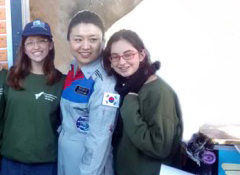Is this science writer jazzed that ninth-grade girls from a religious girls’ school in Jerusalem won a space/science contest? You bet your sweet solar-powered spacelab she is! It is not just that these girls beat out a lot of other classes (over 400), or that they break more than one stereotype. They also came up with a pretty clever idea for studying the Sun: Send a spacecraft to scatter assorted nanolabs all over an asteroid that is about to pass close to the Earth on its way to the Sun. The contest is held every year in memory of Israeli astronaut Ilan Ramon, who went down with the crew of the Columbia space shuttle in 2003. Middle-school classes all over the country vie to design space missions, and the top classes receive telescopes for their schools.
 Korean astronaut Yi So-yeon with two members of the Ilan Ramon Space Olympics winning team
Korean astronaut Yi So-yeon with two members of the Ilan Ramon Space Olympics winning team
The top 12 classes, by the way, had a lecture from a female astronaut – South Korea’s Yi So-yeon. Women might not yet be set to take over the space program, but from where we are sitting, it looks like there is definite hope.
In other news from the Weizmann Institute, “over-generalization” – when your brain mistakes harmless stimuli for dangerous ones – is not only a real thing, in those who suffer from anxiety it can arise from patterns that become hardwired into the brain. Researchers found that attaching emotional stimuli, for example gaining or losing money, to hearing a tone can make a subject less able to later distinguish that tone from another, similar one. That was especially true for subjects who normally suffer from anxiety, and fMRIs of their brains showed that their response patterns work a bit differently, so they can’t help their seemingly irrational emotional responses to benign events.
Our brains may overgeneralize under stress; but we are actually pretty good at recognizing detail – better than a computer. In other research, scientists pitted 15,000 humans (hired from Mechanical Turk) against computers to see how well each is able to reconstruct a mental image from photos that had either been cropped or their resolution lowered. Humans beat computers hands down, but the interesting thing is that nearly all humans fail the test at the same point. Remove a couple of pixels, and suddenly most people are unable to name that image. This suggests several things. One is that our brains have some basic “atomic” unit of detail that we require to recognize an object. Another is that our brains process images in two ways at once, simultaneously constructing a whole from the details and comparing the images our eyes perceive to those in our memory banks. Computer vision – the ability of computers to identify objects in images – has come a long way in the last few years, thanks, in part, to work at the Weizmann Institute of Science. But it is still far from perfect, and this research points to possible improvements.
 A small change in images at the minimal recognizable configurations (MIRC) level can cause a large drop in human recognition rate. MIRCs (top) and corresponding sub-MIRCs (bottom); numbers under each image indicate the human recognition rate
A small change in images at the minimal recognizable configurations (MIRC) level can cause a large drop in human recognition rate. MIRCs (top) and corresponding sub-MIRCs (bottom); numbers under each image indicate the human recognition rate
For more examples, check out their website: http://www.wisdom.weizmann.ac.il/~dannyh/Mircs/mircs.html
- Log in to post comments